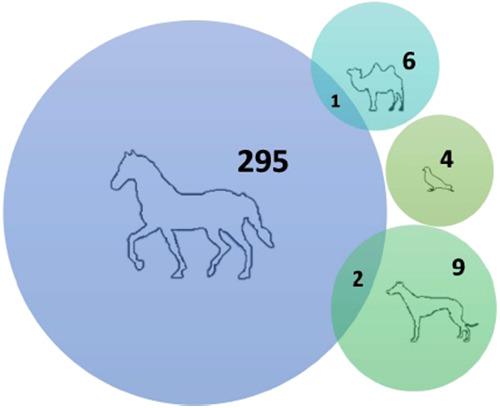当前位置:
X-MOL 学术
›
Drug Test. Anal.
›
论文详情
Our official English website, www.x-mol.net, welcomes your
feedback! (Note: you will need to create a separate account there.)
Doping detection in animals: A review of analytical methodologies published from 1990 to 2019
Drug Testing and Analysis ( IF 2.6 ) Pub Date : 2021-01-13 , DOI: 10.1002/dta.2999 Fernando Moreira 1, 2, 3 , Helena Carmo 1 , Paula Guedes de Pinho 1 , Maria de Lourdes Bastos 1
Drug Testing and Analysis ( IF 2.6 ) Pub Date : 2021-01-13 , DOI: 10.1002/dta.2999 Fernando Moreira 1, 2, 3 , Helena Carmo 1 , Paula Guedes de Pinho 1 , Maria de Lourdes Bastos 1
Affiliation

|
Despite the impressive innate physical abilities of horses, camels, greyhounds, or pigeons, doping agents might be administered to these animals to improve their performance. To control these illegal practices, anti‐doping analytical methodologies have been developed. This review compiles the analytical methods that have been published for the detection of prohibited substances administered to animals involved in sports over 30 years. Relevant papers meeting the search criteria that discussed analytical methods aiming to detect and/or quantify doping substances in animal biological matrices published from 1990 to 2019 were considered. A total of 317 studies were included, of which 298 were related to horses, demonstrating significant advances toward the development of doping detection methods for equine sports. However, analytical methods for the detection of doping agents in sports involving other species are lacking. Due to enhanced accuracy and specificity, chromatographic analysis coupled to mass spectrometry detection is preferred over immunoassays. Regarding biological matrices, blood and urine remain the first choice, although alternative biological matrices, such as hair and feces, have been considered. With the increasing number and type of drugs used as doping agents, the analytes addressed in the published papers are diverse. It is very important to continue to detect and quantify these drugs, recognizing those that are most frequently used, in order to punish the abusers, protect animals' health, and ensure a healthier and genuine competition.
中文翻译:

动物兴奋剂检测:1990 年至 2019 年发表的分析方法综述
尽管马、骆驼、灵缇犬或鸽子具有令人印象深刻的先天身体能力,但可能会对这些动物施用兴奋剂以提高它们的表现。为了控制这些非法行为,已经开发了反兴奋剂分析方法。本综述汇编了已发表的分析方法,用于检测 30 多年来对参与运动的动物施用的违禁物质。考虑了 1990 年至 2019 年发表的符合搜索标准的相关论文,这些论文讨论了旨在检测和/或量化动物生物基质中掺杂物质的分析方法。共纳入 317 项研究,其中 298 项与马有关,表明马匹运动兴奋剂检测方法的发展取得了重大进展。然而,缺乏检测涉及其他物种的运动中兴奋剂的分析方法。由于提高了准确性和特异性,色谱分析与质谱检测联用优于免疫分析。关于生物基质,血液和尿液仍然是首选,尽管已考虑替代生物基质,例如头发和粪便。随着用作兴奋剂的药物的数量和类型不断增加,已发表论文中涉及的分析物也多种多样。继续检测和量化这些药物,识别最常用的药物,以惩罚滥用者,保护动物健康,并确保更健康和真正的竞争,这一点非常重要。由于提高了准确性和特异性,色谱分析与质谱检测联用优于免疫分析。关于生物基质,血液和尿液仍然是首选,尽管已考虑替代生物基质,例如头发和粪便。随着用作兴奋剂的药物的数量和类型不断增加,已发表论文中涉及的分析物也多种多样。继续检测和量化这些药物,识别最常用的药物,以惩罚滥用者,保护动物健康,并确保更健康和真正的竞争,这一点非常重要。由于提高了准确性和特异性,色谱分析与质谱检测联用优于免疫分析。关于生物基质,血液和尿液仍然是首选,尽管已考虑替代生物基质,例如头发和粪便。随着用作兴奋剂的药物的数量和类型不断增加,已发表论文中涉及的分析物也多种多样。继续检测和量化这些药物,识别最常用的药物,以惩罚滥用者,保护动物健康,并确保更健康和真正的竞争,这一点非常重要。尽管已经考虑了替代生物基质,例如头发和粪便。随着用作兴奋剂的药物的数量和类型不断增加,已发表论文中涉及的分析物也多种多样。继续检测和量化这些药物,识别最常用的药物,以惩罚滥用者,保护动物健康,并确保更健康和真正的竞争,这一点非常重要。尽管已经考虑了替代生物基质,例如头发和粪便。随着用作兴奋剂的药物的数量和类型不断增加,已发表论文中涉及的分析物也多种多样。继续检测和量化这些药物,识别最常用的药物,以惩罚滥用者,保护动物健康,并确保更健康和真正的竞争,这一点非常重要。
更新日期:2021-03-10
中文翻译:

动物兴奋剂检测:1990 年至 2019 年发表的分析方法综述
尽管马、骆驼、灵缇犬或鸽子具有令人印象深刻的先天身体能力,但可能会对这些动物施用兴奋剂以提高它们的表现。为了控制这些非法行为,已经开发了反兴奋剂分析方法。本综述汇编了已发表的分析方法,用于检测 30 多年来对参与运动的动物施用的违禁物质。考虑了 1990 年至 2019 年发表的符合搜索标准的相关论文,这些论文讨论了旨在检测和/或量化动物生物基质中掺杂物质的分析方法。共纳入 317 项研究,其中 298 项与马有关,表明马匹运动兴奋剂检测方法的发展取得了重大进展。然而,缺乏检测涉及其他物种的运动中兴奋剂的分析方法。由于提高了准确性和特异性,色谱分析与质谱检测联用优于免疫分析。关于生物基质,血液和尿液仍然是首选,尽管已考虑替代生物基质,例如头发和粪便。随着用作兴奋剂的药物的数量和类型不断增加,已发表论文中涉及的分析物也多种多样。继续检测和量化这些药物,识别最常用的药物,以惩罚滥用者,保护动物健康,并确保更健康和真正的竞争,这一点非常重要。由于提高了准确性和特异性,色谱分析与质谱检测联用优于免疫分析。关于生物基质,血液和尿液仍然是首选,尽管已考虑替代生物基质,例如头发和粪便。随着用作兴奋剂的药物的数量和类型不断增加,已发表论文中涉及的分析物也多种多样。继续检测和量化这些药物,识别最常用的药物,以惩罚滥用者,保护动物健康,并确保更健康和真正的竞争,这一点非常重要。由于提高了准确性和特异性,色谱分析与质谱检测联用优于免疫分析。关于生物基质,血液和尿液仍然是首选,尽管已考虑替代生物基质,例如头发和粪便。随着用作兴奋剂的药物的数量和类型不断增加,已发表论文中涉及的分析物也多种多样。继续检测和量化这些药物,识别最常用的药物,以惩罚滥用者,保护动物健康,并确保更健康和真正的竞争,这一点非常重要。尽管已经考虑了替代生物基质,例如头发和粪便。随着用作兴奋剂的药物的数量和类型不断增加,已发表论文中涉及的分析物也多种多样。继续检测和量化这些药物,识别最常用的药物,以惩罚滥用者,保护动物健康,并确保更健康和真正的竞争,这一点非常重要。尽管已经考虑了替代生物基质,例如头发和粪便。随着用作兴奋剂的药物的数量和类型不断增加,已发表论文中涉及的分析物也多种多样。继续检测和量化这些药物,识别最常用的药物,以惩罚滥用者,保护动物健康,并确保更健康和真正的竞争,这一点非常重要。











































 京公网安备 11010802027423号
京公网安备 11010802027423号